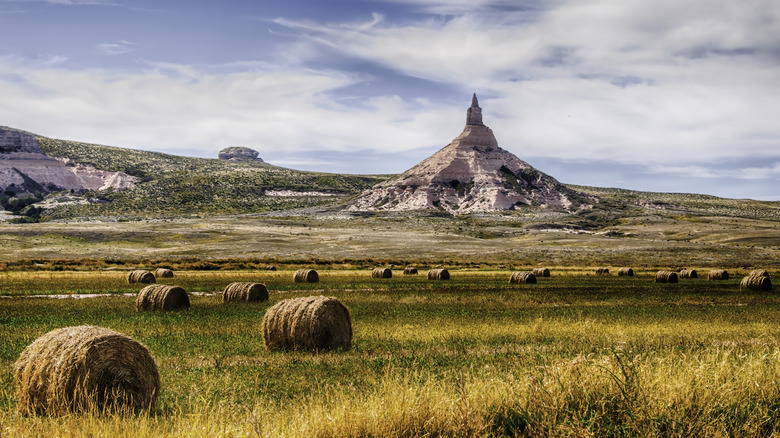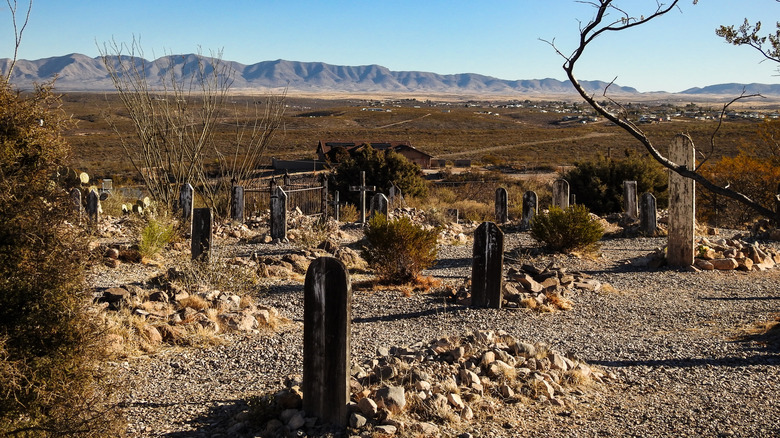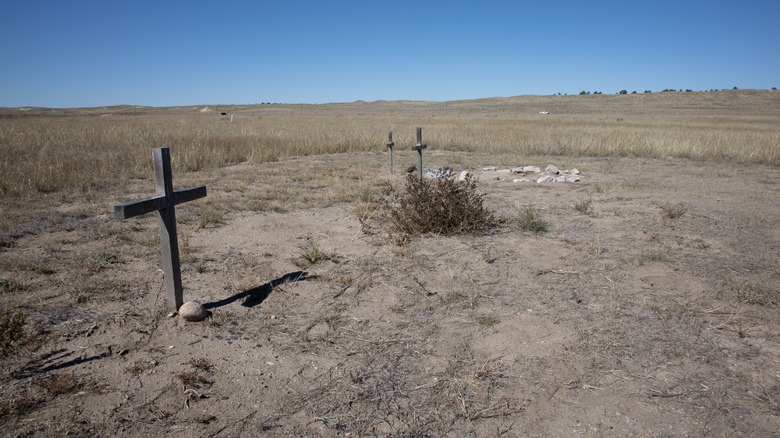The Bizarre Reason It Can Be Legal To Access Someone's Private Property In Nebraska
Driving through the largely flat, beautiful, but austere Nebraskan horizon, you'd be forgiven for thinking that the state consists largely of corn. Plus soybeans and wheat. After all, the state ranks eighth in population density, at about 2 million, and nearly 780,000 of those people live in Omaha and the capital, Lincoln. The population elsewhere is spread out. And amidst all the scattered towns, small communities, and yes, endless fields of crops, sit tiny plots of cemeteries housing handfuls of graves. Many of the people in these "pioneer cemeteries," as they're called, died in Nebraska's 19th-century westward expansion days, and paved the way for the state's subsequent citizenry.
It's not hard to imagine the situation facing homesteaders and settlers in those days. Life was hard, people died, and where were they to be interred? People might have been buried here and there, several at a time, or a bunch clustered together. Families might have moved or stayed somewhere a bit before resettling. Little by little land got bought, property lines got drawn, cities arose, areas got districted, laws solidified, and all of a sudden some local had the area's first black-and-white TV.
But what about those small, scattered pioneer cemeteries? Where are they? Some of them got eaten up by private property. Should these pioneers' ancestors stand at the edges of fields and wave towards the distant headstones of their great-great-great-great-great-grandfathers? Well, Nebraska's got a simple solution for this conundrum, per Nebraska Legislature Statute 12-808.01. Passerbys can simply stroll in and pay a visit to the site whether it's on private property or not.
Nebraska law grants access to pioneer cemeteries
When thinking of Nebraska Legislature Statute 12-808.01, it's probably most realistic to envision huge swaths of land peppered with occasional splotches of old pioneer cemeteries rather than someone's suburban, fenced-off backyard containing a couple of random, weatherworn headstones. Regardless, Nebraska law is clear regarding the rights of visitors and favors visitors over property owners. Anyone can visit a pioneer cemetery at will, relatives or not, with a couple of caveats.
The wording of statute 12-808.01 is as no-nonsense as Nebraska's character and landscape. Dating to 1996, it simply reads, "An owner of property upon which is located a pioneer cemetery affected by sections 12-807 to 12-810 shall not deny pedestrian access to such cemetery as prescribed by this section." Statutes 12-807 to 12-810 address the care and maintenance of pioneer cemeteries. Statute 12-807 says that if 35 residents of a county petition for it, then the county is obligated to provide "continuous preservation and maintenance, including mowing, of an abandoned or neglected pioneer cemetery." Statue 12-810 says that after five years a sign can be placed directing people from the nearest highway to the cemetery, and the cemetery gets a historical marker.
Regarding visitors accessing pioneer cemeteries, they ought to inform the owner of the property ahead of time if possible, but not mandatorily. On the property owner's side, the owner can help steer people in the right direction by putting up a designated path to reach the cemetery. No fuss, no muss.
Nebraska's long pioneer history
If you're wondering "Why Nebraska?" when it comes to pioneer cemetery rules and regulations, we need look no further than the state's history. Nebraska served as a major thoroughfare during the United States' 19th-century westward expansion. Before it became a state in 1867, the original Nebraska Territory stretched from Canada down to Kansas Territory (modern-day Oklahoma). Spanish and French colonialists arrived first in the 17th century, fought over the land, and after that, it served several crucial functions in the burgeoning United States: destination for homesteaders, agricultural hotbed, and westward traveler's route. And yes, it was a part of the famed Oregon Trail, a series of routes that carried 300,000 to 500,000 people westward from 1841 to 1884. In such harsh traveling and living conditions, it stands to reason that plenty of graves were hastily buried, and lots of people forgotten and buried in unmarked graves.
That being said, other states have laws related to pioneer cemeteries, too. In Iowa, a pioneer cemetery is defined as having 12 or fewer graves having been dug at least 50 years ago. As the Des Moines Register quotes Steve Story, President of the State Association for the Preservation of Iowa Cemeteries, each of Iowa's 99 counties not only has pioneer graves but there are as many as 60 to 80 of them. In 1998, the California Office of the Attorney General debated whether pioneer graves qualified as public or private in order to determine the nature of state protectorship over them. Such questions have been settled in Nebraska, and folks can visit such semi-protected places as they please.


